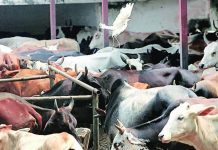This article is written by Anurag Singh from ILS Law College, Pune. This is a comprehensive article that critically analyses the laws on cow slaughter
Table of Contents
Introduction
Politics, policies, and criticism have been an integral part of the Indian democratic system. With every changing government, no matter how good or bad they were, there are some laws, policies, or decisions that stay in the limelight due to their controversial nature. One such topic has been the laws formulated for the ban of cattle slaughter in 2017 under The Prevention of Cruelty to Animals (Regulation of Livestock Markets) Rules 2017. It will not be out of place to state here that mere banning of the cattle slaughter was not a topic of discussion; there was an angle of religious bias and the economy being affected by it. Therefore, let’s understand the topic in-depth.
Proposed laws against cow slaughter
The framers of the Indian Constitution initially wanted the preservation of cows to be made a fundamental right but after a lot of discussions and brainstorming, the matter of cow slaughtering was put into Article 48 of the Constitution as a directive principle of state policy. This Article says that states should make conscious efforts towards banning the slaughtering of cows and calves and draught cattle.
In the case of Mohd. Hanif Qureshi & Ors. v. State of Bihar (1958), the Supreme Court upheld a total prohibition of slaughter of the cows of all ages and calf of buffaloes (male and female) & she-buffaloes, breeding bulls, and working bullocks, without prescribing any test of requirement as to their age. However, the Supreme Court overturned this decision in the case of State Of Gujarat v. Mirzapur Moti Kureshi Kassab (2005), and the seven judges bench reached the following conclusions:
- That a total ban on the slaughter of cows of all ages and calves of cows and calves of she-buffaloes, male and female, is quite reasonable and valid and is in consonance with the directive principles laid down in Article 48.
- That a total ban on the slaughter of she-buffaloes, or breeding bulls or working bullocks (cattle as well as buffaloes) as long as they are as mulch or draught cattle is also reasonable and valid.
- That a total ban on the slaughter of she-buffaloes, bulls, and bullocks (cattle or buffalo) after they cease to be capable of yielding milk or of breeding or working as draught animals cannot be supported as reasonable in the interest of the general public.
24 out of the 28 states have implemented laws regulating the slaughtering of cattle in their states. However, the 8 states that have not implemented any restriction on the slaughter of cows cannot profit from the same because according to the existing meat export policy in India, the export of beef (except carabeef) has been prohibited.
Moreover, specific legislation has also been enacted with regards to the slaughter of cows under the Prevention of Cruelty to Animal Act, 1960; a new set of rules were formulated under the direction of the Supreme Court in the case of Gauri Maulekhi v. Union of India called the Prevention of Cruelty to Animals (Regulation of Livestock Markets) Rules 2017. Under the ambit of these rules, the Ministry of Environment, Forest and Climate Change banned the sale of all kinds of cattle for slaughter at animal markets nationwide. However, the notification expanded the scope of cattle. Therefore, it now covers bulls, bullocks, cows, buffaloes, steers, heifers, and calves, as well as the camel trade.
The difficulty associated with cow slaughter
Like every other living being, the cows also have a life cycle. Being born and getting old is an inevitable part of a living being. Importantly, when the cow gets old, it is not as productive as before. Therefore, the owner of the cow has to sell it to the slaughterhouse because no other agriculturist would, in their right mind, buy a cow that is of no use to them.
However, the old cows are not completely useless to the farmers, because they sold the old cows to get the money to buy another healthy one and this cycle goes on and on. As far as the sale of cows is concerned, nowhere in the law, it states that the sale of cows is banned, they can be sold, however, not to a slaughterhouse. Furthermore, the purchaser cannot sacrifice the cattle, after the purchase, for religious belief as is still a practice in some rural areas.
Laws related to animal protection in India
Animal protection is a huge issue, not only in India but all around the globe because most or at least some products that we use in our daily life, either directly or indirectly, come from an animal. From the milk we drink to the leather jacket that we wear, all these things are by-products of animals. However, when it comes to respecting them, many people lack such an aspect.
Therefore, the government has formulated various animal protection measures to widen its scope. Moreover, when the Constitution was amended in 1960, a new article was added in the Indian Constitution i.e. Article 48A, which is a Directive Principle of State Policy (DPSP). Therefore, it is the duty of every citizen under this directive principle to protect nature, its resources, and its living being. Moreover, it is a fundamental duty of every citizen under Article 51A (g) of the Constitution, to protect wildlife and have compassion for all living creatures.
There is also a legal provision prescribed under the Indian Penal Code, 1860. Any person killing, maiming, poisoning, or rendering useless any animal or animals shall be punished under Section 428 and 429 of the Code. Moreover, the Central Government has also taken active steps by formulating laws for animal protection, which are:
- Prevention of Cruelty to Animals Act, 1960
- The Wildlife Protection Act, 1972
These two Acts by the Centre ensure the protection of cattle, wild animals, aquatic animals, birds, and animals. However, there is always a tussle between the state and central laws because, on one hand, item 14 of the State List gives power to the states to formulate laws concerning the preservation and protection of stocks to ensure the health and well being of the animals but on the other hand, item 17 and 17B of the concurrent list gives powers to both state and center to formulate laws for ensuring the protection wild animals and bird and also prevent cruelty against animals.
Laws that allow animal slaughter for commercial purposes
However, with all this talk around the slaughter of cattle, it should not be forgotten that India still consumes meat. In fact, poultry meat is the fastest-growing component of global meat demand, and India is rapidly growing in the poultry sector. Moreover, this industry has been growing 8 to 10% every year exponentially as a result of which, India is amongst the 18 largest producers of broilers.
The Prevention of Cruelty to Animals (Slaughter House) Rules, 2001 lays down the condition for the sale and purchase of broilers in India. Collaterally, it also ensures the good health of broiler chickens before the sale and humane conditions before their sale. Even though they are used for consumption, they should not be treated as a commodity but should be given due respect.
Need for a non-discriminatory animal protection law
Therefore, the disparity between laws is undeniable. On one hand, the State takes active steps to ban the slaughterhouse for cattle but also continues to allow the export of broiler chicken. Either of them is not wrong but the State should take one stand whether to allow the slaughter of meat consumption or not and then implement the same for all the animals.
In addition to the aforementioned point, it knowingly or unknowingly suggests that the one living being is more important than another, what this does is bows a seed in the minds of the citizen that the government is practicing Hinduism in the country in broad daylight, though the same might not be intended. This should not be the case in a secular country. Therefore, it is evident that non-discriminatory animal protection laws are essential for India.
Religion and law – does one drive the other
The anti-slaughter laws of cows are a sensitive topic because it has a religious side to it as well. As we all know, India is a secular country, and people from various ethnic groups and religions reside in India. Therefore, the lawmakers in the country, along with the welfare of the country, have to keep in mind that none of the religious sentiments are harmed. This was the sole reason behind the formation of different personal laws for different religions.
Every religion has its own set of beliefs. However, the government has often been criticized for the formation of laws that favour any religion, anti-cow slaughter laws can be considered one such law. Due to the sacred nature of cows for Hinduism, Sikhism, Jainism, Buddhism, and Zoroastrianism. However, they are considered an accepted form of meat for Muslims and Christians.
Therefore, prohibiting the use has pleased one set of people but has also created a void for the other community. ‘Void’ not just in the context of the consumption of beef as a source of food but it has also created a void for the community that depended on the exports of beef as a source of income. Interestingly, India exports beef worth $4 billion annually, and that the ban is already causing concern over a potential rise in global beef prices due to reduced supply.
Communal violence after the ban
Moreover, an increase in India’s cow vigilantism has been observed in recent times. According to a report by Human rights watch (HRW), between May 2015 and December 2018, at least 44 people (including 36 Muslims) were killed across 12 Indian states. Over that same period, around 280 people were injured in over 100 different incidents across 20 states. The report also suggests that the majority of the victims in these attacks were either Dalits or Muslims, a majority of these slaughterhouses and meat shops were mostly run by Muslims and Dalits who traditionally dispose of cattle carcasses and skin them for commercial purposes such as leather and leather goods.
The Supreme Court in the case of Tehseen S. Poonawalla vs Union Of India (2018) issued a series of directives for “preventive, remedial and punitive” measures to address “lynching”, the term used in India for killing by a mob, however, in this case for cow vigilantism. While cow protection is an emotional issue for many Hindus, taking the matters into their own hands was not acceptable behavior. Therefore, the Supreme Court directed volunteers of cow protection to not resort to violence against any person or group. Moreover, it also denounced violent attacks by cow protectors, saying: “It is imperative for them to remember that they are subservient to the law and cannot be guided by notions or emotions or sentiments or, for that matter, faith.”
The beef ban in India has not only economically affected India but has also created a rift between the people who consume beef and the people who do not. Earlier the group of people who consumed beef and the people who did not coexisted, as their worlds never clashed with each other. However, even though it was formulated for the protection of cattle, this ban has been perceived to be favoring one religion.
Conclusion
It has been held in Hinsa Virodhak Sangh vs Mirzapur Moti Kuresh Jamat (2008) and in Re-Ramlila Maidan Incident Dt vs Home Secretary And Ors (2012) that what one eats is one’s personal affair and forms part of the right to privacy under Article 21. However, it should also be kept in mind that cruelty towards the animals before consumption is also not acceptable as well. Therefore, it’s the job of the government to bridge the gap and also formulate uniform anti-discriminatory laws for animal protection so that the country is not divided based on what meat they consume.
References
- https://www.youtube.com/watch?v=9m618BjAJxQ
- https://www.forbes.com/sites/leezamangaldas/2017/06/05/indias-got-beef-with-beef-what-you-need-to-know-about-the-countrys-controversial-beef-ban/?sh=11adfe5e53c2
- https://www.animallaw.info/article/overview-animal-laws-india#:~:text=Protection%20of%20animals%20is%20enshrined,protection%20and%20cow%20slaughter%20prohibition
https://www.thehindu.com/news/national/cattle-trade-rules-go-against-1960-law/article18595229.ece - https://theconversation.com/hinduism-and-its-complicated-history-with-cows-and-people-who-eat-them-80586
- https://www.latestlaws.com/articles/beef-ban-in-india-legal-perspective-by-aayush-akar/
Students of Lawsikho courses regularly produce writing assignments and work on practical exercises as a part of their coursework and develop themselves in real-life practical skills.
LawSikho has created a telegram group for exchanging legal knowledge, referrals, and various opportunities. You can click on this link and join:
https://t.me/joinchat/J_0YrBa4IBSHdpuTfQO_sA
Follow us on Instagram and subscribe to our YouTube channel for more amazing legal content.











